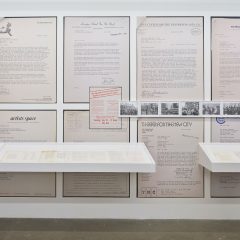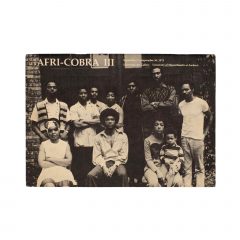(Brandon Joyce, co-founder of the late, great art incubator, PiFAS, writes from Los Angeles about Century City, a weird and (to him) wonderful place.–the Artblog editors)
Corporate hive by day, Century City by night is as lifeless as Mars. Even security guards are absent or asleep at their posts. First coming across it, years back, on a long wordless nightwalk with a friend, I got to explore its spaces unimpeded. We paused and rolled around in the weird curvy landscaping and gazed up at the office windows above, where a few fluorescents hummed on: “Who are you, friend, toiling away on a Saturday night?” It’s definitely the latest iteration of Los Angeles Noir: stark, unsentimental, yet filled by the imagination with a cynical drama happening behind glass enclosures… Deals brokered, careers made and shattered, divorce papers delivered by fax…You get the idea.
Stillness between Westwood and Beverly Hills

Wedged down between Westwood and Beverly Hills, and weighing in at around 180 acres, the area barely registers with local consciousness. People know the mall, a Westfield, and have usually noticed some angular corporate geometries on the way to Santa Monica, but even Google struggles to explain the area in human terms (try it— the results read like the yellow pages).
http://www.youtube.com/watch?v=GguyIer4Itk
Backstory
Century City was built in the 1960’s, which explains a lot. The land, once belonging to 20th Century Fox and used as its studios, was sold off to developers to help Fox with its financial crunch over the filming of Cleopatra. Originally dreamt up among Fox executives and friends, then financed by aluminum giant Alcoa, the idea was huge: a “city within a city,” a 60’s blueprint utopia of offices, residences, and shopping, glittery with style and Hollywood luster. To draft the master plan, they sought out architect Welton Becket, and who better? Becket was the architect responsible for numerous Los Angeles landmarks, such as the Capitol Records Building, the geodesic Cinerama Dome, and the Santa Monica Civic Auditorium. These sites are now iconically Socal; despite the fact that the buildings have no strong architectural signature, and that Becket has long been accused of making placeless and generic architecture (the Equitable Life Building comes to mind). But the buildings are likeable, in the way that you like a family member without thinking of them as a genius. Becket also designed for his friend, Walt Disney— the “Contemporary Resort” at Disneyland— and you can feel the kinship in their misplaced Californian imagineering (such as Walt Disney’s favorite attraction which he named, without irony, “The Carousel of Progress”).
The greening of Century City’s Darkitecture
Century City is far less happy-go-lucky. Maybe that’s just because I spend most of my time there after hours, or because of the architects brought on to design the buildings: I.M. Pei, Minoru Yamasaki, Charles Luckman. The buildings are uninviting, trans-human, and feel like large rising shards of black glass and aluminum. Darkitecture, we’ll call it. But as with Becket’s sunny designs, I still like them. In fact, I almost love them. Are they good architecture? Maybe, I don’t know, some. Are they human, friendly, green, relevant, celebrated? No, not really, and for these reasons there’s come about a push for renovation— which always leaves me pretty skeptical. The proposed “greening of Century City,” undertaken by Rios Clementi Hale Studios, plans to rework Century City into a greener, walkable, sustainable neighborhood, enlivening its street levels with “strolling loops,” “interactive art events,” “cafes and eateries.” And though the intentions are good, I really wish they wouldn’t.
An alternate proposal
I know I’m weird. What others see as a wasteland— industrial decay, strip malls, “bad” neighborhoods, Times Square even— I usually see as a land of opportunity, as a place of unappreciated liberties and lessened annoyance. As a line in Brecht goes: “Wo Spinnen sind, gibt’s wenig Fliegen”— where you find spiderwebs, you’ll also find fewer flies. I can wander around Century City, with a beverage, and feel the chill of it all. The public privacy. An entire city to myself. I obviously wouldn’t expect planners and developers to accept this as a reason against renovation. There are better ones. Attempts to nice-ify the area will only dampen its real charms, or make it more commensurable with the adjacent mall and surrounding area. Why would we ever want to blend in better?
Why not go the exact opposite direction, take a stand, double-down on its failed Epcot weirdness— even to the point of self-awareness? Latch a bunch of golf-carts together and pretend they’re a levitating monorail. Build a hologram shrine to Buckminster Fuller in that crater in the center of the place, whatever it is. Greet visitors with strange black cubes that move through the sidewalks on their own, emitting low frequency tones. We don’t have to go so far as all this, but currently this is what’s interesting about the place. Embrace it. Use it. Don’t apologize. And God save us from any more “nice” urban planning.
http://www.youtube.com/watch?v=Ux0K5QoH2Fg
There have been some recent bids to see Century City as significant for architectural history, such as the defenses that saved Minoru Yamasaki’s Century Plaza Hotel from demolition. However, architectural history is obviously more than styles and forms. It also takes into account mentality. In the case of Century City, its bargain-bin-Corbusier utopianism, its Hollywood executive appeal and client-friendliness, its noirish vibe, its loneliness, its coldness— I don’t think these should be painted over. And instead of working against itself, I see a possible though unlikely future for Century City that looks an awful lot like its present. A place of meditation and retreat from Westside traffic. An afterhours destination without bars or restaurants or music but benches and silence and sleek black machines vending strong coffee. If I wanted to have a real conversation, to clear my head, work out an idea, leave the real world for a placeless place, I’d come on down to Century City. This is my suggestion for the planners, for whatever it’s worth.
Make us work for it.
As it stands, it could use some more footbridges, yes— and maybe the vending machines I suggested (which could double as the humming black cubes). The majority of the work to accomplish this vision, however, would be the work of public imagination rather than renovation. I may be the only person who’d enjoy something like this, but if I wasn’t, would it be asking too much of the public? Here we come to the crux. The “nice” planning, or “nice” architecture, I sniffed at is always planning or architecture that makes it too obvious or easy for the public. It comes to them and makes them feel welcome and at ease in an unthreatening, recognizable environment, and I couldn’t hate this more. I want an architecture that makes me work for it a little bit, or a lot bit, in order to enjoy the rewards. Scary, or at least unsettling, darkitecture. Nobody goes to Mars in order to feel at home. They go for the unknown, the uncanny. Century City is useful enough by day. Wouldn’t it be great if Los Angeles reserved it by night for the Wholly Other?










